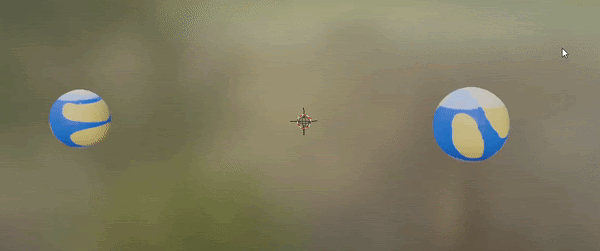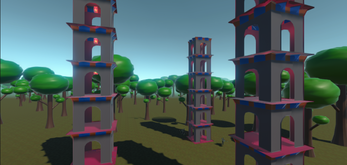Sol'Rand
Controls Forward - W Backward - S Strafe Left - A Strafe Right- D Rotate Left - Q Rotate Right- E Ascend - SPACEBAR Descend - LEFTSHIFT Reset World - ESC
Explorable Area Map

Planet Name: Sol’Rand
Size: Approximately 1.3 times the size of Earth
Observable Description: Sol’Rand is a rocky planet very similar to Earth. Its core is composed of iron and nickel, it has a habitable level of oxygen in its atmosphere, and it contains life. The planet’s crust has a very high concentration of silica, causing large crystal formations to occur even on the surface. There are six major continents on the planet’s surface. Sol’Rand is located just outside of the “Goldilocks” habitable zone of its stars (White A-type and Orange dwarf K-type), but has a significant enough level of volcanic activity to add more heat to the atmosphere. The core is extra active due to Sol’Rund, its twin planet (~1.6 times the size of Earth). The two planets are locked in a tidal locked, binary orbit around each other, both acting as a moon to one another. This extra gravity tugs on the planet’s cores, causing them to be larger and more active.
POD Requirements: The planet contains habitable levels of oxygen, however care should be taken to properly filter any hazardous materials from volcanic activity for human respiration. Areas with little to no volcanic activity will be colder. Proper heat production will be required. Navigation boosters should consider the gravity differentiation during prototyping.
Intelligent Life: The life observed on the planet has been named “Ornush.” They seem to be a bipedal bird-like creature, capable of flight, with intelligence and a society/culture. They do not appear to have any technology that may be a threat to exploration.
Flora/Fauna: Other parts of nature on the planet seem to be very similar to Earth. Many of the fauna, especially those in more isolated locations, seem to have some sort of photosynthetic capabilities.
Composition: Soils tend to be rocky or more clay-like because the planet has a higher concentration or iron and nickel. Observable cave systems seem to have large crystal formations within them. These crystal formations have been observed on the surface as well.
Temperature: Temperatures on the surface range from -100C to 30C
Climate Conditions: Most weather that occurs on the planet occurs near or around the equator. However severe typhoons have been observed to travel through frozen areas, especially if it passes near volcanic areas.. Most of the rest of the oceans are too cold to produce severe weather events.
Geological Events: There are many mountains, volcanoes, hot spots, hot springs, and islands across the planet.
Air Quality: 75% Nitrogen, 22% Oxygen, 1.5% Argon, and 1.35% other gases. Atmosphere contains an ozone layer. CAUTION: Potential hazardous gasses from volcanic activity.
Land to Liquid Ratio: 59% of the surface is liquid or frozen water. 41% is land.
Layers:
Crust: 2% of planets radius. 59% of surface is liquid/frozen water. 41% land.
Mantle: 79% of planets radius.
Core: 19% of planets radius. Iron an nickel.
Atmospheric Qualities: Ozone layer. Aurora Borealis in areas near the poles. Clouds have been observed at most areas of the planet.
Gravity: Sol’Rand’s gravity is approximately 112% of Earths gravity.
Other Information:
One Sol (binary rotation of the two planets) is approximately 60 hours.
There are three other planets in the solar system. One other rocky planet too close to the stars to contain an atmosphere, and two Jovian planets both with a set of rings.

Binary orbit of Sol'Rund (Larger) and Sol'Rand (Smaller).
A project by Tyler Knupp.
Created in Unity with assistance from Professor Kevin Mercer.
| Status | Released |
| Platforms | HTML5 |
| Author | WEREstheWOLF |
| Made with | Unity |
| Tags | Atmospheric, Exploration, Space, Unity |
Development log
- Update 0.3 AlphaMay 03, 2022

Leave a comment
Log in with itch.io to leave a comment.